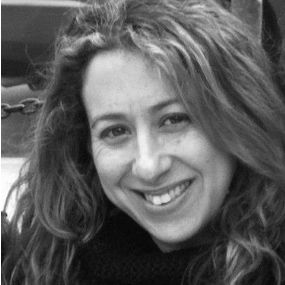How Heroin Came for Middle-Class Moms
Women have moved from popping prescription painkillers to shooting up street drugs. And they're dying because of it in staggering, skyrocketing numbers.

Donna* is from the suburbs. She says so proudly. A really nice town not far from Philadelphia. Donna grew up in a nice middle-class family. She wrote poetry. She had shoulder-length blonde hair and a job at the board of social services.
Today Donna is in a group therapy session at Family First, an outpatient substance abuse program for women.
In 2011, after she gave birth to her son Marco*, now six, a doctor prescribed the then-25-year-old Donna Oxycodone and Xanax for chronic back pain. Donna paid the doctor in cash. It was a “pill mill,” where doctors doled out prescriptions like candy. Her family knew that she was taking a lot of pills, but it wasn’t some drug dealer she was seeing. This was a doctor, after all. And the pills helped. Still, her mother didn’t like it. Her mother thought it was going to lead to something else.
This went on for a while, taking pills without any real issue. And then in 2013, Donna got into a very bad car accident. More prescriptions. Severe depression. A suicide attempt. A stint in rehab. Someone reported the doctor at the pill mill to the DEA and the place shut down. Maybe things were looking up.
Then her husband started taking Percocet for a dislocated collarbone. Here it was again, Oxycodone, right in her house. He became addicted. She didn't—at first. Then her tolerance went up. She spent hours hiding in her bedroom, ashamed. Her mom would watch Marco and her husband would sneak her pills. She hated herself for using.
Percocet isn’t cheap. Percocet is $25 a pill. Heroin is $10 a bag. Donna, of course, didn’t want to do heroin. She had just found out she was pregnant with her second child. Who wants to do heroin when you’re pregnant? But she was taking pills all day every day, and she and her husband could split the $10 bag and feel the same euphoria as with two $25 pills. That’s $50 or $10—what would you spend?

When Donna was 37 weeks along, she had a vision of herself dead in a grave. Either dead or high—she didn’t see an in-between. “I want to be induced,” Donna told her OB-GYN. Donna hated what she was doing to her baby. “I want you to induce me because I want to kill myself.” When you tell an OB-GYN that you’re sniffing heroin and want to kill yourself, they don’t induce you. They call the Department of Children and Family. The OB-GYN found a clinic that could get Donna on methadone. Three days later, at 38 weeks, she had the baby. A boy. His name is Dylan*.
Get exclusive access to fashion and beauty trends, hot-off-the-press celebrity news, and more.
Now Donna drives about 20 miles to Camden, New Jersey, every day to sit at the methadone clinic from 7 a.m. to 1 p.m. Three times a week she comes to the group and individual therapy sessions at Family First. She's decided to send Marco to private school and Dylan stays with Miss Charlotte in the small nursery on the first floor of the building while Donna goes to therapy. She likes the women here. She likes the counselors.
She and her husband could split the $10 bag and feel the same euphoria as with two $25 pills. That’s $50 or $10—what would you spend?
But Donna hates Camden. Camden scares her. It’s filled with people with addictions, she says. Plus, the methadone regiment is restrictive. If she misses a dose, she gets reprimanded. If she misses a dose, she gets sick. She calls it “Methadone Prison.”
It’s working, though. Donna has been heroin-free for 126 days. But she doesn’t feel free. Her husband is in rehab and she can’t visit him there. She wants to move on with her life. When will she move on with her life? How?
At treatment centers like Family First, patients generally fall into two groups: Women like Donna who started pain medication for a physical ailment like dental surgery, a cesarean section, or back pain, and women who were addicted to heroin. It used to be that these groups had nothing in common. There were women who did pills, and there were women who did heroin. But now these groups have merged. “Most of our pill clients have moved on to heroin,” says Therese Benyola, director, child protection and welfare reform substance abuse programs at the Center for Family Services. “We still get women that are just doing pills, but there aren't as many.”
A simple Google search spits back dozens of these stories, stories of nice moms from nice communities becoming addicted to, and for some, eventually dying of heroin: A 33-year-old mother who passed out on the floor of a coffee shop, high on heroin, while her 7- and 9-year-old kids sat nearby. A 36-year-old woman from Long Branch, New Jersey, who went to the police station to access public records then went to the bathroom and overdosed.
Thirty or 40 years ago, the typical female heroin addict was less likely to have completed high school or to be employed, and she was more likely to struggle with money, or be on welfare, or turn to sex work. In 1979, University of Michigan researcher Victoria Binion spoke with 170 heroin-addicted women in treatment centers in Detroit, Los Angeles, and Miami. More than half of the women were black, and many had the same narrative: Their drug use was closely related to family issues during their teenage years. Drugs were perceived as an “inner city problem,” says Nicole Porter, director of advocacy for The Sentencing Project, a non-profit that promotes criminal justice reform.
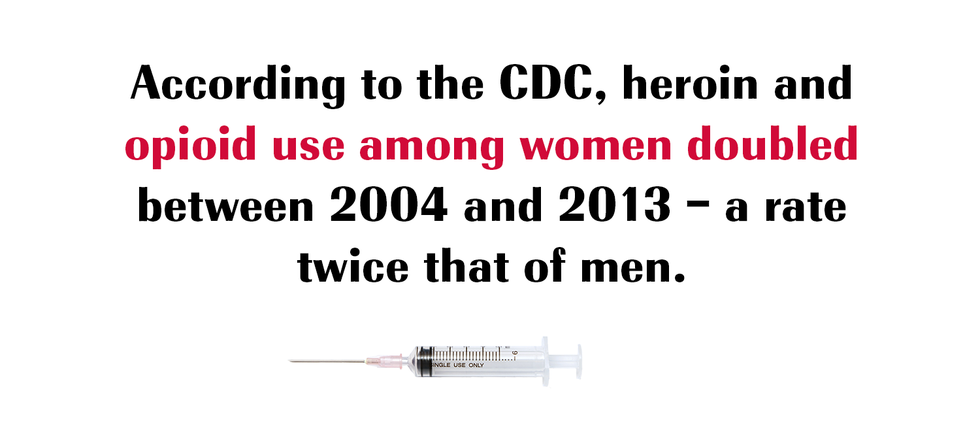
By 2013, a new sort of woman was using heroin: Affluent women. Middle aged, middle-class women with carpools. Gen X moms recovering from knee surgeries. College girls with double majors. Women with incomes above $50,000 and private health insurance. Women who had been taking Oxycodone and Vicodin because they’re excellent pain-relievers. Superior to a vodka tonic. Better than smoking a joint.
The CDC declared opioid abuse an epidemic in back in 2011. In October, President Trump declared the epidemic a health emergency. According to the CDC, heroin and opioid use among women doubled between 2004 and 2013—a rate twice that of men. More women are dying from prescription pain pills than ever before. Since 1999, the number of fatal overdoses among women has increased 400 percent, among men, 265.
The black cloud of drug use respects no boundaries; it reaches its spindly fingers to all corners of the country, touching all demographics. And while the newest data shows there are still far more men addicted to opioids and heroin, women have become uniquely addicted to the substances and at an alarmingly faster rate.
A number of factors leave women more susceptible to addiction than men. Harvard Medical School assistant psychiatry professor Hilary Connery, M.D., Ph.D., who is also clinical director of McLean Hospital’s Alcohol and Drug Abuse Treatment Program in Belmont, Massachusetts, puts it this way: For women, addiction works like a formula. Women have a higher burden of mental health issues, like depression, anxiety, and trauma-related disorders, and this higher burden means women are more likely to be prescribed benzodiazepines or opioids—both of which have a numbing effect or, quite simply, offer a pleasurable release from stress.
“There’s more opportunity for women to be exposed to this,” says Dr. Connery. “It’s a significant aspect of why we’re seeing women develop prescription pill use disorder and dependence.”
Katherine’s voice escalates when she talks about the first time she did heroin, like she’s having an orgasm over decadent chocolate cake.
To properly understand American women’s relationship to addictive substances, one needs to examine the history of advertising in the pharmaceutical industry. During the 1960s and ’70s, years of disproportionate household duties and neglectful husbands and crying kids were vanquished with the help of a hot new drug: Valium. Valium, a benzodiazepine, or tranquilizer, was known as “Mother’s Little Helper,” marketed to “reduce psychic tension,” to make all that emotional pain go away. By the 1980s, stronger benzodiazepines (e.g. Ativan and Xanax) prescribed for anxiety disorders were also made available to help overwhelmed women.
When OxyContin hit the market in 1996, it was considered the gold standard of painkillers. It’s hard to believe now but opioids like OxyContin were advertised to doctors as less addictive, and were, in turn, prescribed to patients as harmless relief from back pain, migraines, endometriosis, and pregnancy-related pain—just a step above Advil. The advertising slogan? “Get in the Swing with OxyContin.” OxyContin cured everything. Except it didn’t: It was just as addictive and as soul-sucking as any other opioid, advertisements notwithstanding.
By 2008, women were reporting more use and abuse of prescription opioids than men. And women were taking OxyContin not just for pain, but as an alternative to Valium or Xanax. Because Oxy took the edge off.
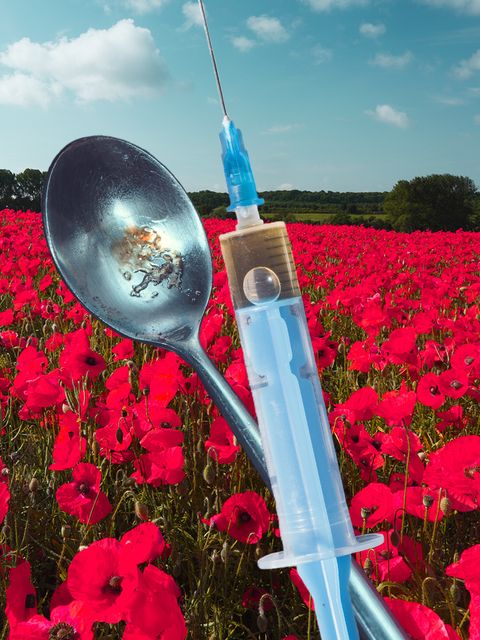
Katherine*, for example, a mother in her late 30s who lives in Massachusetts, got hooked on opioids after her daughter fractured her skull in a car accident. It was a terrifying time. Her daughter was a bright high schooler, but when she woke up after the accident, she didn’t know the answer to four plus four. Here was Katherine, sitting in the hospital, worried to death about her daughter. The daughter was in horrendous pain and had been prescribed Percocet for her injuries. What would it hurt to take one of her pills? Just to sleep. Just to take the edge off.
Katherine was only going to use it occasionally she told herself, but that was her first lie. “Even at the time I started, I kind of knew it was going to be the beginning of the end,” Katherine says now. Within a couple of weeks, her daughter’s prescription ran out.
Katherine knew a woman from the neighborhood, someone she grew up with whose husband owned a construction business and sold opiates at his work sites. She called her. “I have a friend of mine who needs some heroin,” Katherine told the woman. That was her second lie. It made her feel better about herself to lie because what kind of mother took heroin? It seemed absurd.
The first time she did heroin, “Oh, my God.” Katherine’s voice escalates when she talks about it, when she she remembers that feeling, like she’s having an orgasm over a decadent chocolate cake. It was heaven on earth. It was stronger than anything—way stronger than the pills—and Katherine loved it. It took everything away. All of her worries about her daughter’s recovery, her stress about work, her marriage, her mortgage. It was all gone.
In 1999, four years after OxyContin was approved by the FDA, just over 1,000 women died of a prescription painkiller overdose; by 2010, that number had increased to 6,600. States started cracking down on doctors and started passing laws enabling doctors to check patients’ opioid history through a national database.
But by that time, America was already addicted. You can take away the prescriptions, but that doesn’t eradicate the dependence. Middle class women went looking for pills on the black market. And they found cheap, pure, street heroin, available in droves. Entrepreneurial Mexican cartels had recognized American demand and capitalized on it. In 2014, Mexican opium production increased by 50 percent, the New York Times reported.
Black women weren’t sent to rehab: They were sent to jail.
It sounds like an enormous leap to go from swallowing medicine to snorting or shooting heroin, but that’s exactly how our current crisis transpired. According to an analysis by JAMA Psychiatry, 75 percent of heroin users started with an addiction to prescription painkillers.
The two are chemical cousins. Both are made from opium poppy plants or synthetic opium, and both interact with certain receptors in the brain. “Normally women wouldn’t start out using heroin because there’s such a taboo with that drug,” explains psychiatry professor Stephen Ross, M.D., director of the substance abuse program at NYU Langone Medical Center. “But with heroin packaged as a pill, prescribed by a doctor and dispensed by a pharmacist, the perception of harm isn’t there.”
Before our country awoke to the horror of this epidemic, saw how big and bad and all-encompasing it was, there was no Family First. The response was punitive. If you were on heroin, you went to jail. Period. Many women experienced what Porter of The Sentencing Project deems “the girlfriend problem.” These were the romantic partners of major offenders—drug kingpins or traffickers—who were caught up in the take-down of a ring.
In 2000, black women were imprisoned at six times the rate of white women—a direct correlation to the drug war, which targeted black neighborhoods, and a lack of treatment alternatives, according to Porter. Black women weren’t sent to rehab: They were sent to jail.
The demographics of jails have shifted as well. By 2009, the rate of black women incarcerated decreased by half, while the rate of incarceration of white women increased. There was a 37 percent increase in drug offenses by white women between 2000 and 2009. More white women have become involved in criminal activity—while the opposite is true for black women—mainly because of opioid use.
Once Eva* was pregnant, she couldn’t hide the track marks. Getting knocked up wasn’t supposed to happen. She looks like your average mom now, her hair pulled back in a bun. A gray T-shirt. Jeans. Her skin clear of makeup. But Eva tried heroin as a teen and never stopped wanting more. She vomited all over herself the first time she tried it. That didn’t matter; she was hooked. She points to the faint lines trailing up her arms. “They’re scars now,” she says. “But they used to be bad.”
Sometimes she’d use pills, too. She did a lot of doctor shopping in the early aughts. She’d go to one doctor to get Klonopin and then another doctor to get Xanax. Pay one with her insurance and one with cash.
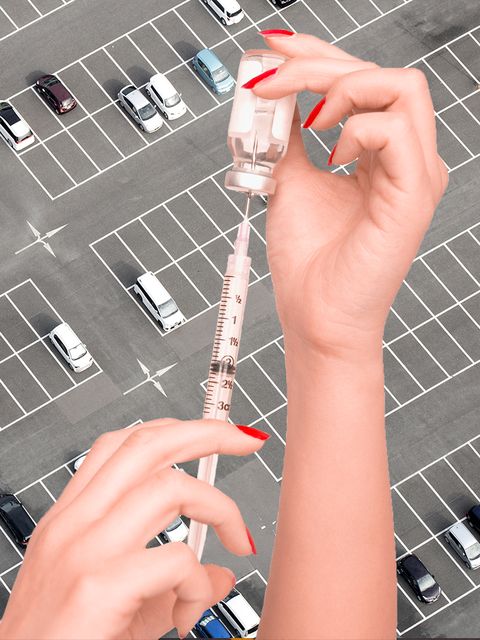
Eva conceived while she was high. She didn’t tell anyone, just told herself every day: You’re not pregnant. Go get high and forget about it. The minute she arrived at the hospital in labor, she told the doctor she was on heroin. They brought her right to the delivery room. What seemed like minutes later, the baby came.
“The nurse, I don’t even remember her name, god bless her, she told me, ‘This is your chance. Get your life together. Talk to somebody. They’ll help you.’ I got all emotional and cried. I said, ‘You’re right. I can do this.’”
Eva had gone to rehab 20-some-odd times. Nothing worked. Until she had her baby, Christopher*. Now, she's another patient at Family First. Christopher is celebrating his first birthday there. He gets a Teenage Mutant Ninja Turtle block set and a T-shirt emblazoned with “Little Slugger.” There’s a colorful cake with his name and a candle.
Christopher sits on Eva’s lap, eating cake and smiling at the women in the room. They’re all mothers, all addicted to drugs. “Do you like that Christopher? Do you like the cake?” Eva says, cooing, feeding him. Christopher’s a good baby. Eva is taking him to the zoo on Saturday if it’s not too hot.
Women, unlike men, have a biological increased vulnerability to drugs. Causing them to become addicted at a much faster rate, a disturbing phenomenon doctors call “telescoping.” Telescoping is the rapid progression from using a substance for the first time, to getting hooked, to becoming completely addicted—like what happened to Eva. Hormones are contributor; addiction can be affected by a woman’s menstrual cycle.
This is how Jill B. Becker, Ph.D., a psychology and psychiatry professor at the Molecular and Behavioral Neuroscience Institute at the University of Michigan, explains it: At the beginning of addiction, the drug activates your brain’s dopamine system—your brain gets off on both wanting and liking the drug. Eventually, the “liking” part of your brain levels off. There’s no longer a high. But the “wanting” part never shuts down. In women, hormones like estradiol, a type of estrogen, drive the “wanting” reaction.
“At certain times of your cycle you’re more likely to say, ‘Boy, I want to do that again,’” says Dr. Becker. “And if you do it again and again, eventually the hormones aren’t nearly as important and the drugs take over.”
When a woman takes heroin, she's challenging our society's notion of femininity.
How do we save women like Donna? Like Katherine? Like Eva? Society is more forgiving of a male heroin addict than a female one. When a woman takes heroin, explains Jennifer Friedman, Ph.D., who co-authored the book Surviving Heroin, she’s challenging our society’s notion of femininity. The female role is defined by someone who is clean, stable, can multi-task, can have children, can be a nurturer. But heroin is a drug for deadbeats and rebels and outliers.
The majority of therapeutic clinics and centers were originally designed for male needs, not female. Family First, where Donna and Eva received treatment, opened in 2004 as a gender-specific program. They eliminated barriers like child-care and transportation issues by simply offering babysitters and rides. There’s trauma-based therapy, parenting groups, relapse prevention. It’s a one-stop shop designed for women. At the time, there was nothing like it in the area.
Particularly concerning is the increase in the incidence of maternal opioid use. Data released this month by the CDC shows that the number of new moms addicted to opioids has quadrupled since 1999. Pregnant women are prescribed opioids for low back pain. For pelvic pain. For joint pain. Migraines. And while most prescription opioids are classified as category C (drugs are classified for pregnant women by potential risk factors, with A being the least risky and D the most) Oxycodone is a category B drug, the same as Advil. Animal studies have shown no conclusive harm to the fetus, but one 2105 review of opioids and pregnancy published in the Journal of Pediatric Genetics concluded that the drugs might be associated with certain birth defects. What's worse, that same recent report from the CDC highlights an association between opioid exposure and pre-term labor, stillbirth, even maternal mortality.
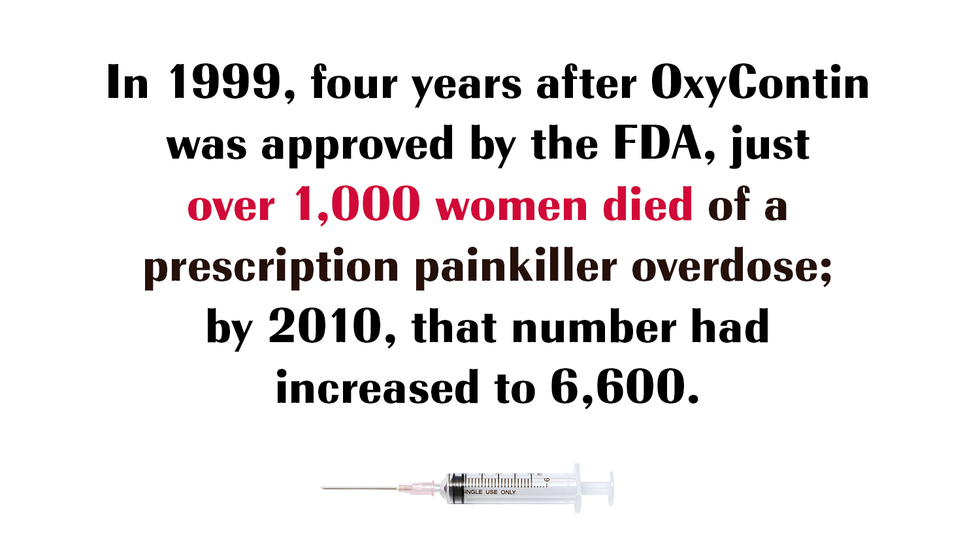
Women who are pregnant and addicted often isolate themselves. They’re ashamed. They’re afraid to come clean to doctors out of fear that their children will be taken away. For some, like Eva, they’ll avoid prenatal care all together. Despite the national conversation around heroin use in this country, some states still penalize women for admitting their addiction.
Last year, the American Congress of Obstetricians and Gynecologists advised pregnant women that the only path to detox is through medication-assisted treatment such as methadone or buprenorphine (Subutex). Throughout her pregnancy, Stephanie told her son’s father that she was on Subutex. That wasn’t the truth. The truth was, she was on dope. She broke the news to her son’s father in the delivery room. “Your baby is addicted to heroin,” she told him.
Stephanie is talking about her experience in a group meeting at Family First. She gave birth to her son on a Friday night, she says, and on Sunday morning when they were getting ready to leave the hospital, the baby was crying, crying, crying. They didn’t drug test the baby, or her, because she had no history. Stephanie’s OB-GYN hadn’t tested her when she was pregnant—and why would she? Stephanie didn’t show any symptoms of drug abuse, she claims. She waited in the hospital room for them to take the baby away from her. Why aren’t they taking him? she wondered.
She broke the news to her son’s father in the delivery room. “Your baby is addicted to heroin.
As an exercise, the women are asked to write letters to their children. Stephanie reads hers: “The feelings of shame and disgust are still there,” she says, “but this isn’t about me, this is about you.”
Stephanie’s story propels the group into a discussion about Subutex. There’s one pregnant woman in the group on Subutex; she’s been watching videos of babies withdrawing from heroin on YouTube. The whole room screams. Don’t do that. Why would you do that? No. No. No. No matter what you do, don’t watch babies withdrawing. It gives her nightmares, she says. She feels guilty as hell that she’s pregnant. Doctors told her there won’t be any side effects from the Subutex, but how do they really know?
Forgiveness is a large component of the discussion. Bambii Kreal, the counselor leading the group, explains this to Stephanie. “Give yourself credit for doing the right thing,” Kreal says. “You could have gone home with a crying baby and said nothing.” Instead, Stephanie came clean to the doctors in the hospital. She got help for the baby. Then for herself. Today she’s graduating the treatment program. She got a job that pays her more than the national average. Stephanie wants to see it Kreal’s way, but it’s hard.
“Do you ever forgive yourself?” Kreal asks the group. She doesn’t direct the question at any one person. It’s more of a concept she’s handing to them: Without forgiveness, there is no recovery.
One woman, a graduate of the program, speaks up. She comes back for some sessions and sits in the corner of the room behind the rest of the women. To get support, to give support. She’s thin and older. Less anxious than many of the women. Less jumpy. “At some point you do forgive yourself. But it takes a while.”
*Names have been changed.

If you or someone you know is struggling with substance use or abuse, the Substance Abuse and Mental Health Services Administration has resources that can help.
Hayley has written for The New York Times, The New York Times Magazine, Refinery 29, Racked, Talking Points Memo, The Hairpin, and more. She also writes a semi-regular pop culture newsletter, So Very. She lives in New Jersey with her husband and two children.
